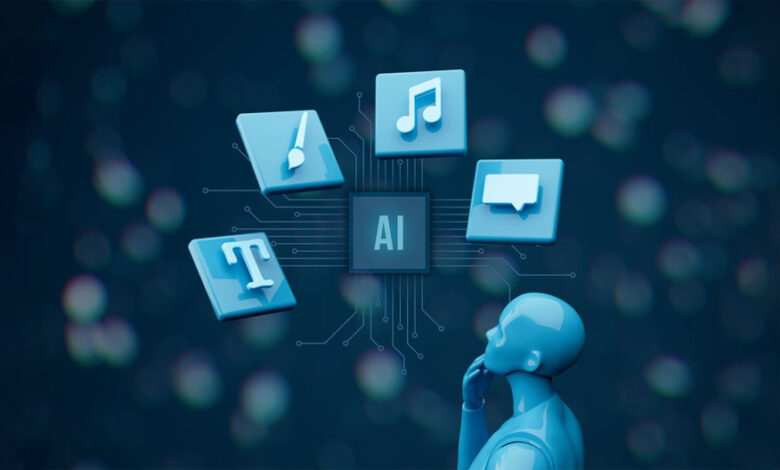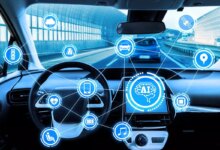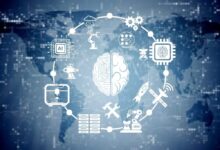The Impact of Generative AI Brings A Creative Future

The world of artificial intelligence (AI) is undergoing a seismic shift, one that is fundamentally changing our relationship with technology and creativity. While early forms of AI were focused on analyzing data and automating tasks, a new and more powerful paradigm has emerged: generative AI. This class of AI models is capable of creating new and original content, from text and images to music and code. It’s a transformative force that is moving AI from a tool of automation to a partner in creation, unlocking a new level of human potential and disrupting industries across the globe. This article will take a deep dive into the core concepts of generative AI, explore its game-changing applications in various sectors, examine the significant ethical and societal challenges it presents, and unveil the immense opportunities that lie ahead for a more creative and efficient future.
The Essence of the Creative Machines

Generative AI is not just about regurgitating existing data; it’s about learning the underlying patterns and structures of a dataset and then using that knowledge to create something entirely new. This is a profound leap from earlier AI models that were primarily designed for tasks like classification and prediction.
A. The Foundational Models
Generative AI is built on a variety of foundational models, each with its own unique strengths and applications.
- Large Language Models (LLMs): These models, such as GPT-4, are trained on vast amounts of text data from the internet. They can understand and generate human-like language, making them capable of everything from writing articles and poems to summarizing complex documents and engaging in natural conversation.
- Generative Adversarial Networks (GANs): GANs consist of two competing neural networks: a “generator” that creates new content (e.g., a fake image) and a “discriminator” that tries to distinguish the real content from the fake. This adversarial process forces the generator to improve its output, leading to incredibly realistic images, videos, and other media.
- Diffusion Models: These models learn to generate data by starting with random noise and gradually “denoising” it until a coherent image or piece of content is formed. This technique is behind many of the latest text-to-image generators, such as Midjourney and DALL-E.
B. The Power of Prompts
A key feature of generative AI is its reliance on “prompts”—natural language instructions that guide the AI’s creative process. A simple text prompt can lead to a stunning visual, a complex piece of code, or a detailed business plan. This makes generative AI incredibly accessible to a wider audience, as it democratizes the ability to create and innovate without the need for specialized technical skills. It’s a new form of human-computer interaction, where we communicate our intentions to the AI in plain language.
The New Era of Creation
The impact of generative AI is not confined to a single sector; its versatility is leading to a revolution in a wide range of fields.
A. Art and Design
Generative AI is transforming the creative industries by providing artists and designers with a powerful new tool for ideation and creation.
- Accelerated Ideation: A designer can use a text prompt to generate hundreds of different design concepts in a matter of seconds, providing a massive source of inspiration for their work.
- Digital Art and Media: Artists are using tools like Midjourney and DALL-E to create stunning digital art, blurring the lines between human and machine creativity.
- Personalized Content: Marketing teams can use generative AI to create a wide variety of personalized ads, images, and marketing copy, tailoring their content to different audience segments with a level of precision that was once impossible.
B. Software Development and Code Generation
Generative AI is not just writing prose; it’s writing code. This has profound implications for the software development industry.
- Accelerated Development: AI models can generate code snippets, debug programs, and even write entire functions based on a simple text description. This can dramatically accelerate the development cycle, allowing human developers to focus on more complex, high-level problems.
- Prototyping: A developer can use generative AI to quickly prototype a new application or feature, turning a concept into a working model in a fraction of the time.
- Automated Documentation: AI can automatically generate documentation for a code base, a task that is often tedious and time-consuming for human developers.
C. Education and Research
Generative AI is poised to change how we learn and discover new information.
- Personalized Tutors: AI can act as a personalized tutor, providing students with one-on-one help, answering questions, and explaining complex concepts in a way that is tailored to their learning style.
- Scientific Discovery: AI is being used to generate new molecular structures for drug discovery, to create new materials with specific properties, and to help scientists sift through vast amounts of data to find new patterns and insights.
- Creative Writing and Journalism: Journalists and writers are using generative AI to create first drafts, summarize research, and even generate headlines, allowing them to focus on the more human elements of storytelling and analysis.
The Ethical and Societal Challenges
The rapid advancement of generative AI brings with it a host of profound ethical and societal questions that we must address proactively.
A. Misinformation and Deepfakes
Generative AI’s ability to create incredibly realistic fake content, known as “deepfakes,” poses a serious threat to our information ecosystem. It can be used to create misleading political videos, spread misinformation, and harm an individual’s reputation. The ability to distinguish between real and fake content will become a major challenge for social media platforms and the public.
B. Copyright and Intellectual Property
The training of generative AI models on vast datasets of copyrighted material, from art and text to music and photography, raises complex legal and ethical questions about intellectual property. Who owns the content that is generated by an AI? Do the original creators of the training data have a right to be compensated? This is an ongoing legal and philosophical debate that will shape the future of the creative industries.
C. The Future of Work and Creativity
Generative AI will undoubtedly disrupt many jobs, particularly in creative and knowledge-based fields. While it will create new jobs and opportunities, it will also displace others. We must proactively address the need for reskilling and training to ensure that the workforce is prepared for this new era. The question of what it means to be a “creator” will also be redefined as AI becomes a partner in the creative process.
A Collaborative Future
The future of generative AI is not a singular destination but a continuous journey of innovation, ethical deliberation, and global collaboration.
- International Cooperation: As a global phenomenon, generative AI requires international standards and agreements to govern its development and use, particularly in sensitive areas like the creation of misinformation and autonomous systems.
- Interdisciplinary Research: The most significant breakthroughs will come from the intersection of different fields. Combining AI with biology, psychology, and social sciences could lead to new ways of solving complex problems.
- Public Engagement: A robust public dialogue about the opportunities and risks of generative AI is essential. Educating the public about the technology and involving them in the decision-making process will build trust and ensure that it is a force for positive change.
The next frontier of generative AI isn’t just about what the machines can create; it’s about what we, as humans, will create with them. It is a new canvas for human ingenuity, and how we choose to wield this powerful tool will define the future of our society.
Conclusion
Generative AI represents a watershed moment in the history of technology, a profound shift that is moving artificial intelligence from a tool of automation to a true partner in creation. The ability of models to learn the underlying patterns of human expression and then generate original content is unlocking a new level of efficiency and creative potential across every industry. From accelerating the pace of drug discovery and writing code to creating stunning works of art and personalized marketing content, generative AI is a versatile and transformative force. It is democratizing the act of creation, providing powerful tools to anyone with a simple text prompt.
However, as we stand at the precipice of this new era, we must also confront the significant ethical and societal challenges that accompany it. The potential for the creation and widespread dissemination of realistic misinformation and deepfakes is a serious threat to our social fabric and our ability to distinguish between truth and falsehood. The ongoing legal and philosophical debate over copyright and intellectual property rights will fundamentally reshape the future of creative industries and the concept of ownership in a digital age. The specter of job displacement looms large, demanding a proactive approach to reskilling and education to prepare the workforce for a future where human creativity is augmented by, rather than replaced by, machine intelligence. The path forward is one of collaboration, where innovators, policymakers, and the public work together to establish ethical guidelines, create a legal framework, and ensure that the immense power of generative AI is used responsibly for the betterment of all humanity. The future of creativity is not just human or machine; it is a new and powerful symbiosis that will redefine what it means to create, to work, and to live in a world where our imagination is the only limit.




